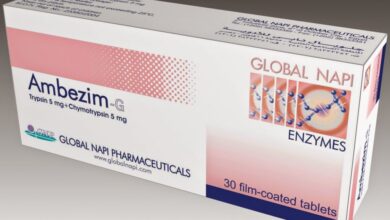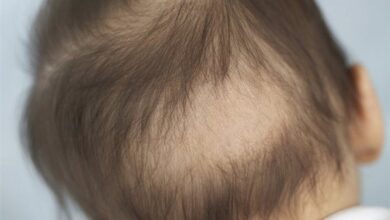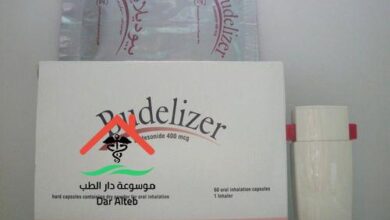دواء يوريكودروب Uricodrop للنقرص | علاجات صيدلية
Price, dosage and instructions for use of Eurykodrop Uricodrop For the treatment of gout, high uric salts in the blood.
What is uricodrop?
- Uricodrop contains “febuxostat.” This active substance belongs to a group of medicines that are inhibitors of the oxidative enzyme xanthine and is used to treat gout, which is related to the presence of an excess of a chemical called uric acid (urate) in the body. Uric acid may accumulate in the blood and it can reach a high level. It is insoluble in some people. When this happens, urate crystals may form in and around the joints and kidneys. These crystals can cause sudden severe pain, redness, warmth and swelling in the joints (known as a gout attack). If left untreated, it may It causes larger deposits called (tophi) in and around the joints and may result in joint and bone damage.
- Euricodrop works by lowering uric acid levels to keep uric acid levels low by taking Euricodrop once every day to stop crystal building. Over time, it reduces symptoms. Keeping uric acid levels low enough for a long time can also reduce symptoms. (deceased).
- Uricodrop is also used to treat and prevent the increase in uric acid in the blood, which may appear when starting to receive chemotherapy, for cancers of the blood, when receiving chemotherapy, the destruction of cancer cells occurs, which leads to an increase in uric acid in the blood, unless the formation of Uric acid.
Indications for use of Eurykodrop:
- To treat gout.
- To prevent gout attacks.
- For the treatment and prevention of high levels of uric acid in the body of patients taking chemotherapy for cancer.
Eurycodrop Ingredients:
- febuxostat ( Febuxostat ).
- Available in two concentrations: 40 mg, 80 mg, and 120 mg.
Dosage and instructions for taking Eurycodrop:
- This medication should be taken exactly as prescribed by your doctor, see your doctor or pharmacist if you are not sure.
- Uricodrop is available in either 40 mg, 80 mg or 120 mg concentrations. Your doctor will prescribe the appropriate concentration for you.
- Gout treatment dose: The usual dose for treating gout is one tablet per day (concentration as directed by your doctor).
- The tablet should be taken with or without food.
- Continue to take this medicine every day, even when you don’t feel a gout attack. (as per doctor’s instructions)
- If you take more Eurycodrop than you should (an overdose), ask your doctor what to do or call your nearest emergency department.
- If you forget to take a dose, take it as soon as you remember unless it is almost time for your next dose, in which case do not take the forgotten dose and take the next dose at the regular time. Do not take a double dose to make up for a forgotten dose.
- Even if you feel better, do not stop taking this medicine without consulting your doctor. If you stop taking this medicine, your uric acid levels may start to rise and your symptoms may get worse due to the formation of new urate crystals in and around your joints and kidneys.
Contraindications to the use of Eurykodrop:
- Do not take this medicine if you are allergic to febuxostat (the active ingredient) or any of the other ingredients of the medicine.
- This medicine should not be used in children under 18 years of age, as the safety and efficacy of the medicine have not yet been confirmed.
- Uricodrop contains lactose (a type of sugar). If you have been told before that you cannot tolerate some sugars, consult your doctor before taking this medicine.
Warnings and precautions for use:
Consult your doctor before you start taking this medicine if you have:
- If you have or have had heart problems.
- if you have or have ever had kidney problems and/or a severe allergy to allopurinol (a medicine used to treat gout)
- If you have and have had liver problems or a defect in the selection of liver functions.
- If you are being treated for high levels of uric acid as a result of Lesch-Nyhan syndrome, a rare genetic disease that causes a very high level of uric acid in the blood.
- If you have or have had a problem with the thyroid gland.
- If you have an allergic reaction to a uricodrop, stop using the medicine. Symptoms of an allergic reaction that may occur include severe effects such as (blistering, pitting, itching, a rash that crusts).
- Swelling in the extremities or face.
- breathing difficulties.
- Fever with swollen lymph nodes.
- Also, a serious life-threatening allergic reaction may occur, leading to cardiac arrest and cessation of blood circulation. Your doctor decides to completely stop the use of uricodrop. A few reports of a life-threatening allergic rash (Stevens-Johnson syndrome) with the use of Furic, starting with the appearance of red spots on the skin or the appearance of Circular spots with blisters in the middle of the leg. Ulcers of the mouth, throat, nose, genitals and lining of the eyelid (swelling and redness of the eye) may also occur. The rash may increase and spread ulcers or blisters on the skin. If you develop Stevens-Johnson syndrome while using febuxostat, you should not re-use Uricodrop at any time. anyway
- If you develop a rash or any of these skin symptoms, consult your doctor immediately and tell him that you are using this medicine.
- If you have a sudden attack of gout (sudden sharp pain, weakness, redness, heat and swelling in the joints), wait until the attack subsides before using this medicine.
- In some people, gout attacks may increase when they start using certain medications that control the level of uric acid. Not all people have a flare-up or an increase in symptoms, but symptoms can also increase with the use of a uricodrop, especially in the first weeks or months of treatment. , It is important that you continue to use Eurycodrop even if you experience an increase in symptoms, as Uricodrop still works to reduce the level of uric acid with time, attacks of gout will decrease and will be less painful while continuing to use Eurykodrop every day.
- Sometimes your doctor will prescribe other medications, if needed, to help prevent or treat symptoms of seizures (such as joint pain and swelling).
- Patients with high levels of urates (such as patients undergoing chemotherapy to treat cancer), treatment with urea-reducing drugs may lead to the accumulation of xanthine in the urinary tract, with the possibility of stones, although this has not been observed in patients who are being treated with puricodrop for tumor lysis syndrome
- Your doctor may order a blood test to make sure your liver is working normally.
Uricodrop with other medicines:
Consult your doctor or pharmacist if you are taking, have recently taken, or could take any other medicines, including medicines obtained without a prescription.
It is especially important to consult a doctor or pharmacist if you are taking medicines containing any of the following substances, as they may interact with uricodrop and the doctor needs to take necessary precautions:
- mercaptopurine (used to treat cancer).
- Azathioprine (used to reduce the immune response).
- Theophylline (used to treat asthma), as there are no adequate studies when theophylline is used with febuxostat.
Uricodrop during pregnancy and lactation:
Due to the lack of sufficient information for the use of this preparation during pregnancy, or if it is transmitted through breast milk, it is best as a precautionary measure, not to use this medicine during pregnancy and breast-feeding, except after consulting the attending physician.
Driving and using machines:
You should be aware that you may experience dizziness, drowsiness, blurred vision, and numbness or tingling sensations during the course of treatment and you should not drive or operate machinery in the event of these symptoms.
Possible side effects:
Like all medicines, Uricodrop can cause side effects, although not everyone gets them.
Call your doctor at once or go to the nearest emergency department if you experience any of the following rare side effects (may affect up to 1 in 1,000 people):
Severe allergic reactions may occur: allergic reaction to the drug, a potentially life-threatening rash characterized by the formation of blisters, shedding of the skin and internal surfaces of the body cavity such as the mouth and genitals, painful ulcers of the mouth and/or genitals, accompanied by fever, inflammation Throat and fatigue (Stevens-Johnson syndrome/toxic epidermal necrolysis), or enlarged lymph nodes, hepatomegaly, hepatitis (may lead to cirrhosis), high level of white blood cells in the blood (drug reaction with white blood cells), generalized rash.
Common side effects (may affect 1 in 10 people):
- Difference in liver function analysis.
- Diarrhea.
- a headache.
- Simple rash.
- nausea.
- An increase in gout symptoms.
- Localized swelling due to fluid retention in body tissues (ascites)
- Uncommon side effects (may affect 1 in 100 people):
- decreased appetite;
- A change in the level of sugar in the blood (diabetes).
- Excessive feeling of thirst.
- An increase in the level of fats in the blood.
- Increase in weight.
- Loss of sex drive.
- difficulty sleeping, drowsiness;
- Dizziness.
- numbness, tingling;
- Loss or change of sensation (hypoesthesia, hemiparesis, or dysesthesia).
- Change or decrease in the sense of taste (decreased smell).
- Heart defect, irregular or rapid heartbeat, heart palpitations.
- Facial glow or sophistication.
- increased blood pressure;
- Bleeding (seen in patients taking chemotherapy due to blood disorders).
- Itch.
- Shortness of breath.
- Chest pain or discomfort.
- Inflammation of the nasal passage and/or throat (upper respiratory tract infection).
- Bronchitis.
- Dry mouth.
- Stomach pain/discomfort or flatulence, heartburn, indigestion.
- Constipation.
- An increase in the number of stools.
- vomiting.
- colic.
- itching, blisters, dermatitis, discoloration of the skin, small red or crimson spots on the skin, small flat red spots on the skin, a flat red area on the skin covered with small bumps, rash, redness in places and spots, other types of skin conditions.
- Muscle spasm, muscle weakness, muscle/joint pain, synovitis or arthritis (inflammation of the joints often accompanied by pain, swelling and/or roughness) pain in the extremities, back pain, muscle cramping.
- The presence of blood in the urine, abnormal urination, abnormalities in urine tests (increase in the proportion of protein in the urine), a decrease in the ability of the kidneys to function abnormally.
- Tiredness, pain in the chest, a feeling of discomfort in the chest.
- Gallstones in the gallbladder or in the bile ducts (the formation of stones in the common bile duct).
- An increase in the thyroid stimulating hormone (TSH) in the blood.
- Changes in oral chemistry or in blood cells or platelets (imbalance in blood test results)
- Kidney stones.
- difficulty having an erection
Rare side effects (may affect up to 1 in 1,000 people):
- Muscle damage is a rare and serious condition that may cause muscle problems, especially if you feel unwell or have a high temperature at the same time. This may be due to abnormal muscle damage. Call your doctor at once if you experience pain, weakness or muscle weakness.
- Acute inflammation of the deeper layers of the skin, especially around the groin, eyes, reproductive system, hands, feet, or tongue, with possible sudden difficulty in breathing, high temperature with measles-like rash, enlarged lymph nodes, enlarged liver, hepatitis ( May lead to kidney damage), an increase in the number of white blood cells in the blood (leukocytes with or without eosinophilia).
- Redness of the skin (dermatitis), rashes of various types (itching, white spots with blisters, blisters with pus, shedding of the skin, measles-like rash), widespread dermatitis, necrosis, blistering of the skin and mucous membranes, which leads to peeling and possible Sepsis (Stevens-Johnson Syndrome / toxic epidermal necrolysis).
- nervous.
- feeling thirsty
- ringing in the ear;
- blurred vision, different vision
- Hair loss.
- Oral ulcer.
- Pancreatitis – common symptoms are abdominal pain, nausea and vomiting).
- increase in sweating;
- Decreased weight, increased appetite, uncontrolled loss of appetite.
- Muscle and/or joint stiffness.
- An abnormally low number of blood cells (white or red blood cells or platelets).
- Urgent need to urinate.
- Change or decrease in the amount of urine due to inflammation of the kidneys.
- Lever Inflammation.
- Yellowing of the skin (yellowishness).
- If you get any side effects, talk to your doctor or pharmacist. This includes any other side effects not mentioned in this thread.
euricodrop price:
- Euricodrop 40 mg (20 Tablets), At a price of 34 Egyptian pounds.
- Euricodrop 80 mg Tablets (30 Tablets), At a price of 69 Egyptian pounds.
- Uricodrop 120 mg Tablets (10 Tablets), At a price of 30 Egyptian pounds.
Data sources & Price & References
Egyptian drug index
Last updated on: May 30, 2022
Uricodrop leaflet
Last updated on: May 30, 2022
The pharmacy treatment website is not responsible for taking the “Uricodrop” medication without consulting the doctor or the pharmacist.
In the event of an inquiry or question about this drug, we are honored to receive your comments at the bottom of the article through the “Pharmacy Treatments” website العدسة نيوز



